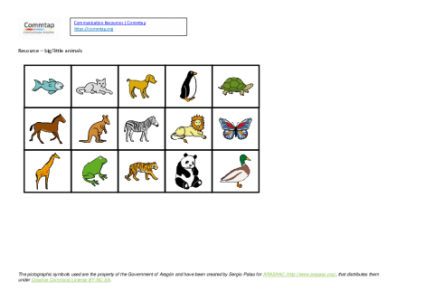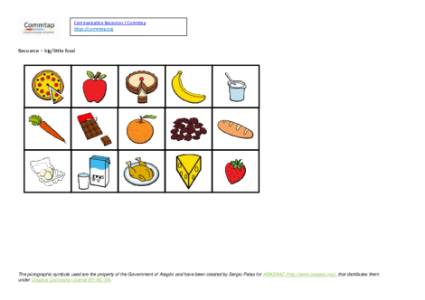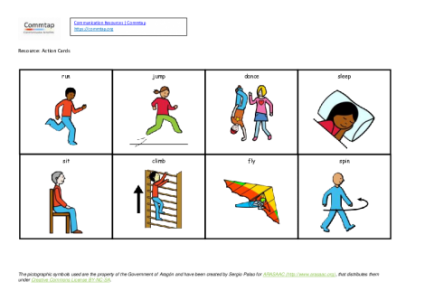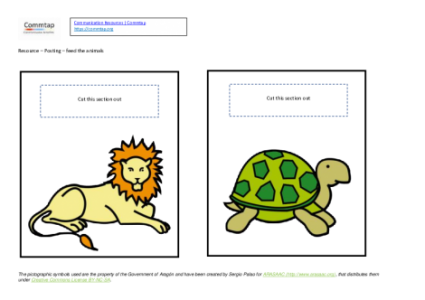Search
User login
Topic “Key words”
understand and use less for quantity
| Activity/strategy name and materials required | How to do the activity | Key principles for doing the activity and comments |
|---|---|---|
| Less food 3 soft toys Plastic tea set Plastic food |
| Avoid working on "less" and "more" together as there is a risk that the child may confuse them. When the child is able to use "less" and "more" on separate occasions in separate activities, you can then use both together in this activity - e.g. ask "More/less banana here?" and so on. |
| Fruit Salad Two bowls and fruit to cut into fruit salad | You could do this activity at snack time - sharing some fruit between two or more children. | |
| Using "less" with various materials See-through plastic cups Materials to put in them, for example: water beans sand pegs bricks pens Optional: symbol for 'less' - this can help to reinforce the concept for some children. If you don't already have one, you can get a symbol for "less" through the Commtap Symboliser. | You need to make the learning very visible. Allow the child to explore materials and give time to respond to questions. Give lots of opportunity for repetition. Provide a central group of items against which 'less' can be compared. Avoid working on "less" and "more" together as there is a risk that the child may confuse them. When the child is able to use "less" and "more" on separate occasions in separate activities, you can then use both together in this activity: use three beakers, have more in one beaker and less in another (than the central beaker). | |
| Sharing out materials Materials, for example: beans sand pegs bricks pens Symbol for 'less' 2 different coloured sheets If you don't already have one, you can get a symbol for "less" through the Commtap Symboliser. | Avoid working on "less" and "more" together as there is a risk that the child may confuse them. When the child is able to use "less" and "more" on separate occasions in separate activities, you can then use both together in this activity: use three sheets, have more in one sheet and less on the other (than the central sheet). | |
| Biscuit decorating Biscuits Something to sprinkle on to them | Avoid working on "less" and "more" together as there is a risk that the child may confuse them. |
understand why questions in context and respond
| Activity/strategy name and materials required | How to do the activity | Key principles for doing the activity and comments |
|---|---|---|
| The Disastrous Day A Playmobil figure or similar Small world objects - some of them broken | 1. Explain that you are going to tell a story about the toy. 2. Tell a story about what the toy does in the day. Lots of things go wrong because the objects are broken e.g. 'want to go to work in the car but it won't move.' 3. Whenever there is a problem for the toy, ask the child 'why?' e.g. 'why won't the car move?' Answer: 'because there is no wheel!' | Give the child a turn at telling the story too. |
| Freddy's Travels A toy character (called Freddy) Pictures of different locations, e.g. beach, mountains One or two items which go with each location e.g. bucket and swimming costume for the beach | ||
| Animal Adventure Pictures of different locations with different 'hazards' or things of interest e.g. a jungle with a river and dinosaurs Two toy animals (wind up toys are ideal) | Use your imagination! | |
| Problem solving Equipment to demonstrate an everyday problem and discuss it. Some examples of equipment you could use: Torch or toy with no batteries; Cup with a hole in it; Dry pasta; Pen with no nib and in; Broken pencil; Dry pen with no lid. | You will need to think of a problem in advance - see the list in the materials column. This activity is ideal to do throughout the child's day, whenever there is a problem to be solved! |
understand and use prepositions behind in front
| Activity/strategy name and materials required | How to do the activity | Key principles for doing the activity and comments |
|---|---|---|
| Behind with easily available objects Cup, box, pencil, ruler (you could substitute different objects if you prefer) prompt cards showing the required positions of the items (optional) | 1. Tell the child that you are going to put the pencil behind the cup - put the objects in the right places. 2. Next tell them that you are going to put the pencil behind the box. 3. Put the pencil and ruler in different places, describing what you are doing. Repeat a number of times as necessary putting different objects behind other objects. 4. Then explain it's the child's turn to put the object in the right place. Say "put the pencil behind the box". If the child gets it right, say, "well done, the pencil is behind the box". If s/he gets it wrong, show them where the pencil goes. 5. Carry on giving the child instructions. 6. Let the child have a turn to give the instructions so s/he practices use the words. If the child finds it difficult to think of what to say, make a set of prompt cards. | Make sure that you sit next to the child when you work on these prepositions - this will make sure that what's "behind" for you will also be behind for the child Each time you describe what you are doing or you ask the child to carry out an action, stress the preposition word so they can hear what the important word in that sentence is. At first you should usually work on contrasting prepositions, such as "behind" and "in front" separately, as working on them together when they are both new to the child can cause the child to be confused between the two. |
| "In front" with easily available objects Materials as above | ||
| Behind and "in front" with easily available objects | Make sure that you sit next to the child when you work on these prepositions - this will make sure that what's "behind" for you will also be behind for the child Each time you describe what you are doing or you ask the child to carry out an action, stress the preposition word so they can hear what the important word in that sentence is. Do this activity only after you have worked on the prepositions separately. | |
| Hide and seek with miniatures Miniature people (such as Playmobil) or Teddy, Doll Places for the miniature people to hide, for example toy furniture, bricks, toy car, book etc. | The more enthusiastically you act his out the better. This game can be highly motivating. | |
| Picture description Several paired pictures showing the same person, animal or object behind and in front of an object (e.g. a cat behind a bin and a cat in front of a bin; a person behind a chair and a person in front of a chair, etc.) Pencil and paper or white board and pen | This activity is particularly useful for children who are mixing up the words "behind" and "in front". Make sure that the child understands that you are expecting a quick sketch, rather than a very careful drawing that would take a long time to execute. |
Understand and use more for quantity
| Activity/strategy name and materials required | How to do the activity | Key principles for doing the activity and comments |
|---|---|---|
| More food 3 soft toys plastic tea set plastic food two bowls and fruit to cut into fruit salad | Have a tea party. Hand out the food. Point out which ones have more. Ask the child to give some food to one of the toys so that it has more. Make fruit salad. In two bowls. Cut up fruit for the 2 bowls and ask "More banana here? Can the child tell you what to put in each bowl using more? | Avoid working on "less" and "more" together as there is a risk that the child may confuse them. When the child is able to use "less" and "more" on separate occasions in separate activities, you can then use both together in this activity - e.g. ask "More/less banana here?" and so on. |
| Various materials See-through plastic cups Materials to put in them, for example: water beans sand pegs bricks pens Symbol for 'more' If you don't already have a symbol for "more" you can find one in the Commtap Symboliser. | You need to make the learning very visible. Allow the child to explore materials and give time to respond to questions Give lots of opportunity for repetition Provide a central group of items against which 'more' can be compared. Avoid working on "less" and "more" together as there is a risk that the child may confuse them. When the child is able to use "less" and "more" on separate occasions in separate activities, you can then use both together in this activity: use three beakers, have more in one beaker and less in another (than the central beaker). | |
| Sharing out materials Materials, for example: water beans sand pegs bricks pens Symbol for 'more' 2 different coloured sheets If you don't already have a symbol for "more" you can find one in the Commtap Symboliser. | Avoid working on "less" and "more" together as there is a risk that the child may confuse them. When the child is able to use "less" and "more" on separate occasions in separate activities, you can then use both together in this activity: use three sheets, have more in one sheet and less on the other (than the central sheet). | |
| Biscuit decorating Biscuits Something to sprinkle on to them | Avoid working on "less" and "more" together as there is a risk that the child may confuse them. |
On under in out
| Activity/strategy name and materials required | How to do the activity | Key principles for doing the activity and comments |
|---|---|---|
| Hiding game "under" 3 common containers e.g. cup, box and hat Small toy e.g. car/ball Teddy | Encourage the child to close their eyes and hide the toy 'under' one container While the child is trying to find the toy model the word 'under'. "Is it under the hat", "Is it under the box" When the child finds the toy encourage them to say where it is. Swap roles the child now has a turn to hide the toy. Using a teddy or another child, pretend teddy is closing his eyes/or ask other child to close eyes and ask the child "Where shall we hide it?" The child then has to say where. | Start with just one preposition and give lots of models of e.g. "under" For expression give forced alternative e.g. "is it under the hat or under the box" When the child has learnt 'under' introduce another preposition and move on to discriminating between e.g. 'in and under' Use sign for 'under' along with the word to help understanding Use everyday situations to model the word 'under' |
| Understanding and using "on" and "under" through physical play Class room furniture PE furniture Playground furniture | Play games in a small group sitting on the chair and sitting under the table, crawling on a mat or carpet and crawling under a table or chair. Comment on what the child is doing e.g. 'Look......you are on the mat' or 'Look........you are under the table' Can the child give instructions about who must go under or on a piece of furniture? This activity is much more fun in a PE setting or a playground if you can arrange it. | Label the children's activities with clear 2 or 3 word phrases. Repeat the phrases over and over again to give lots of learning opportunities. These concepts are taught in contrasting pairs to illustrate the concepts clearly. |
| Understanding "on" and "under" using small toys Small plastic animals or Playmobil people. Boxes and containers to hide the small toys.
| Make this a fun game! Can some children not look while a toy is hidden by another child etc.? | |
| Understanding "in" and "under" when looking at pictures | Give lots of rewards for success and correct mistakes by saying ‘Look........this is on. Dog is on the box’ etc. | |
| Understanding "in" and "out" through physical play | ||
| Understanding "in" and "out" using small toys | Keep the activities fun and snappy! | |
| Understanding "in" and "out" when looking at pictures |
Understand and use one more
| Activity/strategy name and materials required | How to do the activity | Key principles for doing the activity and comments |
|---|---|---|
| Tea party 3 soft toys plastic tea set plastic food two bowls and fruit to cut into fruit salad | Have a tea party. Hand out the food. Point out which ones have more. Ask the child to give a piece of plastic food to one of the toys so that it has one more - say that it has got "one more". Make fruit salad. Use two bowls. Cut up fruit for the two bowls and ask 'One more piece of banana here? Can the child tell you what to add to each bowl using 'one more'? | Avoid working on "one more" and "one less" together until the child has mastered both of these. When both are mastered, you can mix both concepts in this activity, for example asking "one less banana here?" |
| Number line | Avoid working on "one more" and "one less" together until the child has mastered both of these. |
Understand and use one less
| Activity/strategy name and materials required | How to do the activity | Key principles for doing the activity and comments |
|---|---|---|
| Tea party 3 soft toys Plastic tea set Plastic food Two bowls and fruit to cut into fruit salad | Have a tea party. Hand out the food. Point out which ones have less. Ask the child to take away a piece of plastic food from one of the toys so that it has one less - say that it has got "one less". Make fruit salad. Use two bowls. Cut up fruit for the two bowls and ask 'One less banana here? 'Can the child tell you what to take out of each bowl using 'one less'. | Avoid working on "one more" and "one less" together until the child has mastered both of these. When both are mastered, you can mix both concepts in this activity, for example asking "one more banana here?" |
| Number line Number line | Avoid working on "one more" and "one less" together until the child has mastered both of these. |
Activities to develop understanding of 4 key word instructions (nouns/verbs/adjectives/prepositions)
| Activity/strategy name and materials required | How to do the activity | Key principles for doing the activity and comments |
|---|---|---|
| Dinner Time (noun + size + noun + noun) - 2 different soft toys - 2 plates - 2 boxes or baskets | 2. Put the 2 soft toys in front of your child, and put a plate and box/basket in front of each one. 2. Select four or five pairs of pictures (i.e., big and small apple, big and small burger etc.) and spread them out - putting the big and small pictures next to each other. Say the name of each picture as you put them out. 3. Ask your child to put an item of food on the doll's or teddy's plate or basket (e.g. "put the big banana on teddy's plate"). | |
| Place the items (noun + size + noun + noun) |
Activities to develop understanding of instructions containing 2 key words - set 1 (noun + noun)
| Activity/strategy name and materials required | How to do the activity | Key principles for doing the activity and comments |
|---|---|---|
| Shopping game (noun + noun) - printable shopping game pictures - click here - You could substitute the printed pictures for real objects. | 1. Print and cut out the pictures. 2. Put the bag and the trolley in front of the child. 3. Lay the shopping items out on the table. 4. Explain to your child you would like them to do some shopping and put the item in either the bag or the trolley. 5. Some examle instructions you could use: - put the carrot in the bag - put the pizza in the trolley 6. After a few turns, ask you child to give you an instruction. | To simplify to one key word instructions, use the food items with either the trolley or the basket, e.g. put the banana in the basket, put the apple in the basket.
To increase complexity, click here for activities focusing on three key word instructions. |
| Posting Game (noun + noun) | To simplify to one key word instructions, use the food items with either the lion or the tortoise, e.g. give the banana to the tortoise, give the yogurt to the tortoise.
| |
| Picnic (noun + noun) - Toys - tea set, 2 different soft toys and play food. | To simplify to one key word instructions, use the food items with one of the soft toys, e.g. give the banana to the teddy, give the yogurt to the teddy.
To increase complexity, click here for activities focusing on three key word instructions. | |
| Feed the puppets (noun + noun) - 2 hand puppets - Play food |
Activities to develop one key word understanding
| Activity/strategy name and materials required | How to do the activity | Key principles for doing the activity and comments |
|---|---|---|
| Puppet Feeding (nouns) - A hand puppet - Selection of play food | 1. Place the puppet on your hand and lay a few items of play food in front of you. 2. Explain that the puppet is hungry. 3. Give your child instructions, e.g. '(puppet) wants the bread', '(puppet) wants the banana'. 4. Encourage your child to give the puppet the piece of food you asked for. 5. After a few turns, swap roles and see if your child is able to tell you which food to give to the puppet. | You could sign alongside saying the word. For videos of commonly used signs - click here. |
| Find it (nouns) - A selection of every day items - A box | ||
| Action Game (verbs) | You could sign alongside saying the word. For videos of commonly used signs - click here. | |
| Posting (nouns) - Post box - you can make your own with a cardboard box Optional printable post box template here - Picture cards to post - cick here for first words picture cards. | You could sign alongside saying the word. For videos of commonly used signs - click here. |
- « first
- ‹ previous
- 1
- 2
- 3
Support Commtap to keep it online
Thank you for visiting Commtap.
Please read this message as it is extremely important.
- Visitor donations mean we can continue to host over 1,000 free activities to support speech, language, and communication development.
- Visitor donations mean we can continue to provide free resources to address a wide range of communication needs, including limited speech or language, interaction challenges, and needs associated with conditions such as developmental language disorder, autism, and cerebral palsy.
- Visitor donations mean we can continue to provide resources to support the work of speech and language therapists, teachers, teaching assistants, parents, and carers.
- Visitor donations mean we can continue to provide the free key word sign dictionary (bks.org.uk) which has over 2,000 Makaton and Signalong signs.
We know that not everyone is able to afford to pay to access these resources, however, if you can, please make a donation to keep the site going.
Thank you
Google ads on this page are provided by Google Adsense - and their presence does not imply any endorsement by Commtap. Report a problem with an ad on this page. Log in (for free) to avoid seeing Google ads.





